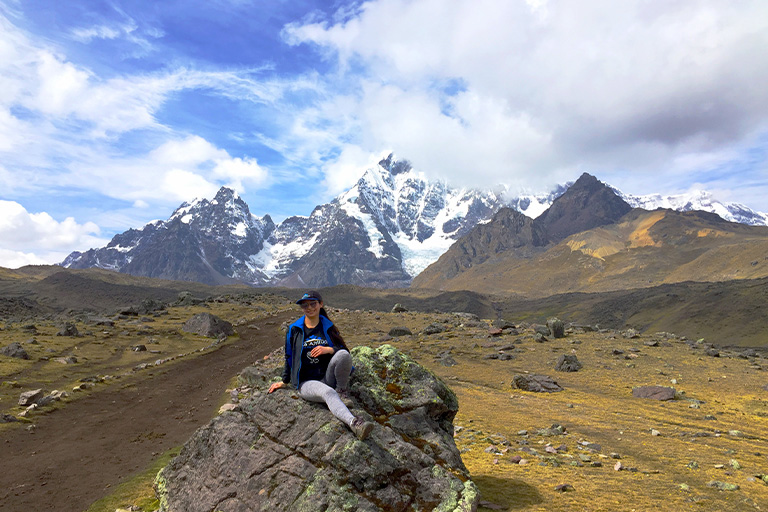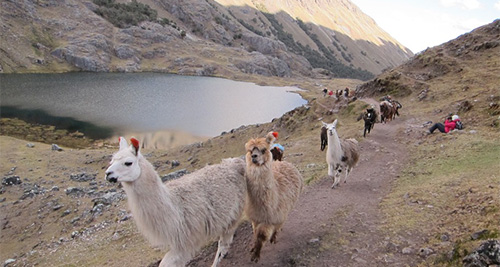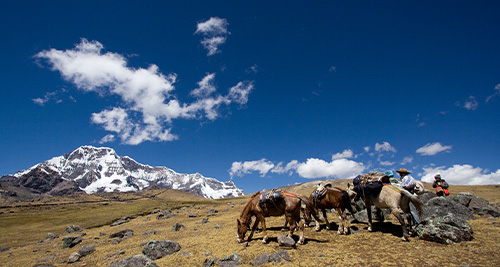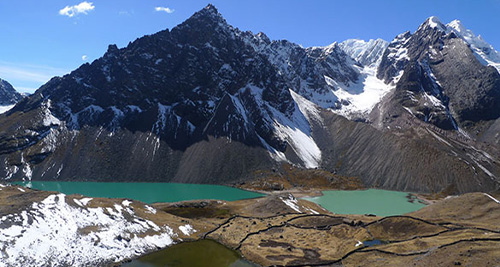
 1 Day
1 Day  From US$ 45,00 per person
From US$ 45,00 per person  Difficulty:
Medium
Difficulty:
Medium  Max. Altitude:
15,912 FT / 4,850 M
Max. Altitude:
15,912 FT / 4,850 M  8.6 MILES / 14 KM
8.6 MILES / 14 KM Explore the Ausangate area in a full-day hike. Visit beautiful lakes and impressive panoramic lookouts. Soak in the inviting hot springs as you gaze out over the Pacchanta highlands.

Local people raise llamas and alpacas for their use; You will be able to see them in their native home.

Marvel at the snow-capped Ausangate Mountain and take amazing pictures of the highlands.

Wander around beautiful alpine lakes and take panoramic views.
PICH UPFORM YOUR HOTEL – PACCHANTA – AUSANGATE LAKES – LUNCH – CUSCO
Our professional tour guide will pick you up at your homestay, hostel or hotel between 4:00 to 4:30 hrs. You must tell our Travel company where you are staying one day before departure and be ready and waiting for pickup.
Temperature during the first hours of our Ausanagte Lakes tour is cold ( 5 to 9°C ) that why you need to bring one extra warm sweater, jacket, hat and gloves. These will keep you comfortable during this driving time to Pacchanta. After 3 hours driving we will arrive at Pacchanta where we will stop for breakfast and get last things you forgot to buy in Cusco like water and snacks.
Once we arrive at this high are (Pacchanta) we will be able to see the beautiful mountains Apu Ausangate (6384) meters above sea level). After a short time to prepare and gather our day packs, we start the 1/30 hour trek to first Lake (about 3 km.) We will be able to enjoy the first lake in our day trek. The way up to Ausangate Lakes is steep and down however our group is small and our guide will let you take your time to enjoy and arrive without pressure.
After enjoying our first view of the lakes there is a optional stop by the local people and enjoy a Mother earth offering.
After we see all lakes we will back to Pacchanta where a local lunch will be waiting for us. Once we finish lunch we can enjoy hotspings and them we will go back to Cusco.
We will arrive at Cusco between 17:00 to 18:00 hrs.
Not included
Shared service price: $.45.00.
Important: Shared service price is only available with agreement passengers to share this service with other travelers (Group site 12 – 19 People approx.)
Private service price: $.220.00. (based on two people)
Included all mentioned before
Group size upon your request, for people who need a personalize and exclusive service
Departure day is according to passenger request
Price for bigger groups are according to group size
Do you need to book a Private tour? Book here.
What you should bring
Important to know before you go to Rainbow Mountain
Not appropriate for
Where is Ausangate 7 lakes located?
Ausangate is located in the Cusco region of Peru, it is about 127 kilometers from the center of Cusco. 3.5 hours with bus or car.
What is Ausangate known for?
Ausangate is known for its stunning mountain scenery, vibrant cultural traditions, and challenging hiking trails.
How long is the Ausangate 7 Lakes trek?
The Ausangate 7 Lakes trek is typically a 1-day trek covering a distance of approximately 16 kilometers. However, some tour operators may offer longer or shorter variations of the trek depending on the level of difficulty and the interests of the hikers.
Is the Ausangate 7 Lakes trek difficult?
Yes, the Ausangate 7 Lakes trek is considered to be a challenging trek due to its high altitude, steep ascents and descents, and varying terrain. Hikers will need to be in good physical condition and have some prior trekking experience to complete the trek comfortably. It is recommended to acclimatize to the altitude by spending a few days in Cusco or other nearby towns before starting the trek.
How high is Ausangate?
The peak of Ausangate is 6,384 meters (20,945 feet) above sea level.
What is the altitude of the Ausangate 7 Lakes trek?
The Ausangate 7 Lakes trek is a high-altitude trek in Peru, and the altitude can vary depending on the route taken. The trek usually starts and ends in Pacchanta, which sits at an altitude of around 4,200 meters (13,779 feet) above sea level.
How many lakes are there in Ausangate?
There are seven main lakes in the Ausangate area, which are collectively known as the 7 Lakes.
What are the names of the 7 Lakes?
The seven lakes are named Pukacocha, Qomerqocha, Jatunpukacocha, Hatun Pukacocha, Q’omercocha, Yanacocha, and Sibinacocha.
Can you swim in the 7 Lakes?
It is generally not recommended to swim in the lakes due to their high altitude and cold temperatures.
How do I get to Ausangate?
The most common way to reach Ausangate is by hiking or trekking, either independently or with a guided tour.
Do I need a guide to hike to the 7 Lakes?
It is recommended to hire a guide or join a guided tour for the hike to the 7 Lakes, especially if you are not an experienced hiker.
When is the best time to hike to the 7 Lakes?
The best time to hike to the 7 Lakes is during the dry season, which is from May to September. During this time, the weather is generally dry and sunny, making it easier to trek and enjoy the beautiful scenery. The months of June to August are typically the busiest and most popular time for trekking in Peru, so it’s advisable to book in advance to secure permits and accommodations.
It’s important to note that the weather in the high Andes can be unpredictable and change quickly, even during the dry season. It’s a good idea to pack warm and waterproof clothing, regardless of when you plan to do the trek.
It’s also worth considering that the Ausangate 7 Lakes trek is a high-altitude trek, with elevations reaching over 5,000 meters (16,400 feet). It’s important to properly acclimatize to the altitude before attempting the trek, regardless of the time of year.
What should I pack for the hike to the 7 Lakes?
Clothing: Dressing in layers is essential for the Ausangate 7 Lakes trek. You will need warm and breathable base layers, insulating mid-layers, and a waterproof and windproof outer layer. Pack a warm hat, gloves, and a scarf for cold mornings and evenings.
Footwear: A good pair of hiking boots with good ankle support and a sturdy sole is essential. Make sure they are waterproof and comfortable for long treks.
Backpack: A backpack of around 30-40 liters will be sufficient to carry your essentials for the trek, including water, food, clothing, and camera equipment.
Trekking poles: Trekking poles can help with balance and reduce the impact on your knees and ankles during the trek.
Water bottles: Bring at least two reusable water bottles and a water filter or purification tablets to refill them during the trek.
Sun protection: The high altitude and proximity to the equator mean that the sun can be intense. Pack sunscreen, a hat, and sunglasses to protect yourself from the sun.
First aid kit: Pack a basic first aid kit with items such as bandages, antiseptic cream, painkillers, and blister pads.
Snacks: Pack high-energy snacks such as nuts, dried fruit, and energy bars to keep you fueled during the trek.
Remember to pack light and only bring what you need for the trek. It’s also important to follow the “leave no trace” principle and pack out all your trash.
Are there any accommodations near the 7 Lakes?
The Ausangate 7 Lakes trek is a challenging and remote trek, and there are limited accommodations along the way. However, there are a few basic options available for trekkers.
The most common accommodation along the trek is camping, and many trekking companies and guides will provide tents and camping equipment for their clients. There are also a few basic campgrounds and refugios (mountain huts) along the route that offer basic shelter and facilities such as toilets and cooking areas. These are generally very basic and do not have amenities like electricity or running water.
In addition, there are a few small communities and villages along the trek where trekkers can sometimes find homestays or guesthouses, although these options are not guaranteed and may require some advance planning and coordination.
Overall, trekkers should be prepared to camp and bring their own food and supplies, as there are limited options for accommodations and services along the Ausangate 7 Lakes trek.
Is it safe to hike to the 7 Lakes?
While hiking in the Ausangate area is generally safe, it is important to be prepared for the high altitude and unpredictable weather conditions.
What is the terrain like along the Ausangate 7 Lakes trek?
The terrain along the Ausangate 7 Lakes trek is rugged and varied, with a mix of high altitude passes, steep ascents and descents, and rocky and uneven terrain. The trek covers a distance of approximately 70 km (43 miles), with altitudes ranging from 3,800 meters (12,500 feet) to over 5,000 meters (16,400 feet).
The trail passes through the Vilcanota mountain range, with stunning views of snow-capped peaks, glacial lakes, and colorful rock formations. The trek also passes through several high altitude passes, including the Palomani Pass (5,200 meters/17,060 feet) and the Ausangate Pass (4,850 meters/15,900 feet), which can be challenging due to altitude and steep inclines.
In addition, the trail includes sections of rocky and uneven terrain, as well as sections with loose scree and boulders. Trekkers should be prepared for variable weather conditions, including cold temperatures, strong winds, and potential snow or rain.
Overall, the Ausangate 7 Lakes trek is a challenging and rewarding trek that requires a good level of physical fitness and experience with high altitude trekking. Trekkers should be prepared for rugged terrain and variable weather conditions, and should take appropriate safety precautions.
What wildlife can I see in the Ausangate area?
The Ausangate area is home to a variety of wildlife, including vicuñas, alpacas, Andean condors, and pumas.
Is there a fee to enter the Ausangate area?
Yes, there is a fee to enter the Ausangate area, which varies depending on the entrance point and the duration of your visit (20 t0 50 soles in total).
Can I hike to the 7 Lakes independently?
Yes, it is possible to hike to the 7 Lakes independently, but it is recommended to hire a guide or join a guided tour for safety reasons.
Are there any cultural experiences to be had in the Ausangate area?
Yes, the Ausangate area is rich in cultural traditions, and visitors can experience traditional weaving, music, and cuisine.
What is the weather like in the Ausangate area?
The weather in the Ausangate area can be unpredictable due to the high altitude and mountainous terrain. Generally, the dry season from May to September is the best time to visit, with clear skies and warm days, but temperatures can still drop significantly at night. During the rainy season from October to April, there can be heavy rainfall and thunderstorms, making hiking more challenging and sometimes dangerous. It is always a good idea to check the weather forecast before setting out on a hike and to be prepared for sudden changes in weather conditions.
How fit do I need to be for the Ausangate 7 Lakes trek?
To undertake the Ausangate 7 Lakes trek, you will need to be in good physical condition and have a good level of fitness and endurance. The trek covers a distance of approximately 16 km and includes steep ascents and descents, high altitude passes, and rugged terrain.
To prepare for the trek, it is recommended to engage in regular exercise and training that involves cardiovascular endurance, strength training, and hiking or trekking. Cardiovascular exercises such as running, cycling, or swimming can help improve your endurance, while strength training exercises such as weightlifting or bodyweight exercises can help build muscle and improve your overall strength.
What is the altitude sickness like on the Ausangate?
Altitude sickness, also known as acute mountain sickness (AMS), can be a common occurrence for trekkers on the Ausangate 7 Lakes due to the high altitudes along the route. Symptoms of AMS can range from mild to severe, and can include headaches, nausea, dizziness, fatigue, and shortness of breath.
To help prevent altitude sickness, it is recommended to take time to acclimate to the altitude before beginning the trek, drink plenty of water to stay hydrated, and avoid alcohol and caffeine, which can contribute to dehydration. It is also recommended to ascend slowly and take frequent breaks to allow the body time to adjust to the altitude.
If you do experience symptoms of altitude sickness, it is important to rest and allow your body time to acclimate. Mild symptoms can often be relieved with over-the-counter medications such as ibuprofen or acetaminophen. However, if symptoms persist or worsen, it is important to seek medical attention immediately, as severe altitude sickness can be life-threatening.
Overall, altitude sickness can be a serious concern on the Ausangate 7 Lakes, and trekkers should take appropriate precautions and be aware of the symptoms and risks associated with high altitude trekking.
Are there any medical facilities along the Ausangate 7 Lakes trek?
he Ausangate 7 Lakes is a remote trek in the Andes Mountains, and there are no medical facilities along the trail. However, some tour operators may have first-aid kits and oxygen tanks available in case of emergency.
In the event of a medical emergency, the nearest medical facilities are located in the city of Cusco, which is several hours away from the trailhead. Therefore, it is important to take necessary precautions and prepare for potential medical issues before starting the trek.
Before embarking on the trek, it is recommended to consult with a healthcare professional and get advice on how to prevent altitude sickness and other potential health issues. It is also recommended to carry a personal first-aid kit that includes basic medications such as pain relievers, altitude sickness medication, and any personal medications that you may require.
If you have a pre-existing medical condition or are unsure about your ability to undertake the trek, it is recommended to consult with a healthcare professional before booking the trek.
Can I rent hiking equipment in Cusco for the Ausangate 7 Lakes trek?
Yes, it is possible to rent hiking equipment in Cusco for the Ausangate 7 Lakes trek. There are several outdoor gear rental shops in Cusco that offer a range of hiking and camping equipment for rent, including tents, sleeping bags, backpacks, trekking poles, and more.
What is the cell phone reception like on the Ausangate 7 Lakes trek?
Cell phone reception can be limited or nonexistent on the Ausangate 7 Lakes, especially in remote areas. While there may be some areas along the trek where you can pick up a signal, it is not reliable and may be intermittent.
Most major cell phone carriers in Peru have coverage in Cusco and other major cities, but coverage can be limited in rural areas like the Ausangate region. It is recommended to check with your cell phone carrier for information about coverage in the region.
If you need to stay connected during the trek, it is recommended to bring a satellite phone or a personal locator beacon (PLB) as a backup communication option. These devices can help you communicate with emergency services or your tour operator in case of an emergency.
Overall, it is important to be prepared for limited or no cell phone reception on the Ausangate 7 Lakes trek and to have alternative means of communication in case of emergency.
Learn more about Ausangate 7 lakes in the following blog: Discovering the Wonders of Ausangate: Trekking the 7 Lagoons for an Unforgettable Experience

Search